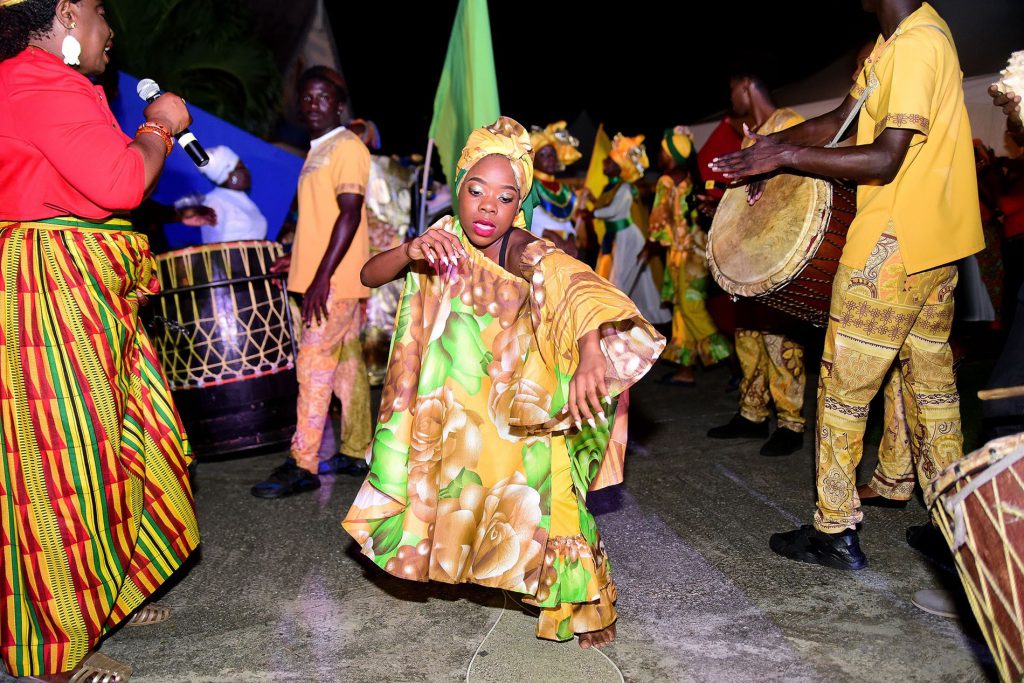
Almost every weekend throughout the year, a different community holds a party to celebrate harvest. Family, neighbours, travellers — everybody is welcome. Just come prepared to dance ‘til dawn
View online at nationalgeographic.com
It’s time to dance. The congregation here in the village of Belle Garden may see me as a visitor in their midst but, right now, I’m just part of the celebration. The choir is on their feet, clapping and singing, while the brass section, keys and percussion players are giving it everything they’ve got. The priest shakes my hand and two ladies jive over to me, stamping their feet, and pulling me into joyful hugs. The atmosphere is electric.
This isn’t a standard Sunday morning service; it’s the morning of the Harvest — an annual celebration that began, centuries back, as a Christian thanksgiving and has grown to become a raucous village-wide cookout that can go on until dawn. It’s held by a different community nearly every weekend throughout the year and – astonishingly – is open for free to the whole island and any wandering travellers. Come by, everyone told me, no questions asked.
The houses along the main street of Belle Garden are hives of activity: gazebos and speaker systems are being erected, crates of vegetables are being lugged to and from kitchens, and out on front lawns men in aprons are tending to bubbling cauldrons of meat. The heat is intense; the smells divine. “The Harvest is important for our civilisation,” a gentleman named Harold tells me. His house is bustling with family and friends, all lending a hand with preparations for this evening. “It’s a gesture. It’s about love across the board, about giving back.” Harold excuses himself, pulling an apron over his head and hurrying back to the kitchen, but not before he helps me pick the ripest mangoes drooping from the tree beside his property. “Swing by tonight for the party!” he shouts as he disappears into the house.
There’s a generosity of spirit in Tobago, a neighbourliness, that strikes me as incredibly rare in this day and age. Wandering next door, I’m welcomed by Dominic. He tells me he’s been up since dawn preparing a menu to impress his guests. A lot of work goes into this day. “Put it this way, tomorrow we will start thinking about next year!” He’s overseeing the callaloo soup, a beloved mix of dasheen leaves, ochre, pumpkin, celery, hot peppers and garlic, which he’s ‘spicing up’ with pigtail. Platters of goat, chicken and crab lie seasoned under banana leaves, ready for the pot. “The best part of the day for me is the preparations and the liming (hanging out) — you know, people coming by to interact,” he tells me. “We’re an island of traditions. I hope I have the fortune to be able to do this every year and that one day my children will keep it on.” I say my goodbyes, promising to come by later for the feast, and am forbidden from leaving without accepting a plate of fresh bread and saltfish — by now, my third breakfast of the day.
Tobago is an island of festivals so it’s likely that any visit will coincide with a riotous cultural celebration. The most famous is Carnival, which sees January and February filled with fêtes (parties), calypso shows and soca concerts that culminate in flamboyant costumed parades on Shrove Monday and Tuesday. Heritage Festival sees the island reconnect with its customs and agricultural roots, with folk dancing, fiddle music, an 18th-century wedding parades and storytelling over the last fortnight in July. And the list goes on: visit around Easter to experience Tobagonians’ unique penchant for goat racing; during the last week of Easter for the Tobago Jazz experience; or on Saint Peter’s Day in June to share in the Fisherman’s Festival. Tobago, it’s clear, knows a thing or two about partying.
I return to Belle Garden at dusk to find the streets busy and music blaring. Harvest is in full swing. I’m handed a sorrel shandy and ushered up the steps to Harold’s house like a guest of honour. I find him gleefully presiding over a dozen pots, piling food high onto paper plates and handing them out to guests. “Be easy! Be happy! Have a good time,” he orders, sending me back outside into the warm evening. I tuck into my provisions — boiled cassava, plantain and sweet potato — then mop up my bushmeat stew with some flaky buss up shut bread. It’s delicious. Then it’s on to the next house, the next party, and the next Harvest dinner. I am starting to get full.
Three more cultural activities to try:
Sunday School
Buccoo’s weekly Sunday School is a religious experience only for those who love to lime (local slang for a relaxed party). The main attraction is The Buccooneers, an award-winning 10-person steel pan band that gets going at 9pm, covering international and soca hits. Later, a DJ takes over and the seafront space fills with locals looking to wind up the weekend with a dance. My guide, Harris of Jungle Tours, insists its the perfect place to find romance. “Some people are like parrots — they’ll mate for life. Others are like Tobago’s Blue Backed Mannequins – they put on a courtship display to find the best partner!” Beers are cheap and there’s street food on sale too, including lobster when it’s in season.
Fort King George & Museum
Tobago’s strategic position off the coast of mainland South America saw it change hands 22 times during the Colonial Era in tussles between the British, French and Dutch. The legacy of these occupations is seen in place names, customs and cuisine today. To get a sense of this formative period in Tobago’s history, visit the well-preserved Fort King George atop Scarborough Hill. I picked up a guide who took me to see bullet-riddled walls, slave cells and tudor cannons — details I may otherwise have missed. The island’s foremost museum is housed in a former barracks here, showing historic maps, colonial trinkets, and the largest collection of native Amerindian artefacts in the Caribbean.
Store Bay Market
The permanent stalls beside the calm Caribbean beach of Store Bay are home to some of the island’s best artists and craftsmen. Visit One Love Arts where Collins Andrews-Toussaint carves and whittles, while his wife, Lerelynne, makes beaded and shell jewellery. Or Sammy and Cats Leather hut for one-of-kind belts and shoes. This is also the spot to try traditional Tobagonian sweets made from crushed coconut and nuts, like sugar cake, toolum and bene balls.
For more information visit visittobago.gov.tt











